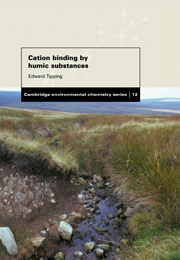Book contents
- Frontmatter
- Contents
- Preface
- 1 Introduction
- 2 Humic substances – a brief review
- 3 Environmental solution and surface chemistry
- 4 Proton dissociation from weak acids
- 5 Metal–ligand interactions
- 6 Methods for measuring cation binding by humic substances
- 7 Quantitative results with isolated humic substances
- 8 Cation binding sites in humic substances
- 9 Parameterised models of cation–humic interactions
- 10 Applications of comprehensive parameterised models
- 11 Predictive modelling
- 12 Cation–humic binding and other physico-chemical processes
- 13 Cation binding by humic substances in natural waters
- 14 Cation binding by humic substances in soils and sediments
- 15 Research needs
- References
- Index
9 - Parameterised models of cation–humic interactions
Published online by Cambridge University Press: 18 August 2009
- Frontmatter
- Contents
- Preface
- 1 Introduction
- 2 Humic substances – a brief review
- 3 Environmental solution and surface chemistry
- 4 Proton dissociation from weak acids
- 5 Metal–ligand interactions
- 6 Methods for measuring cation binding by humic substances
- 7 Quantitative results with isolated humic substances
- 8 Cation binding sites in humic substances
- 9 Parameterised models of cation–humic interactions
- 10 Applications of comprehensive parameterised models
- 11 Predictive modelling
- 12 Cation–humic binding and other physico-chemical processes
- 13 Cation binding by humic substances in natural waters
- 14 Cation binding by humic substances in soils and sediments
- 15 Research needs
- References
- Index
Summary
There have been many attempts to model mathematically the reactions of cations with humic substances. The models developed to date, nearly all of which have been equilibrium models, can be classified as parameterised and predictive. The former operate by data fitting, i.e. by using experimental data to obtain parameter values, while the latter use independent knowledge, or assumptions, to predict the interactions. Parameterised models predominate, with only a few attempts at a predictive approach (see Chapter 11). In this chapter, the concepts behind various parameterised models are presented, while Chapter 10 discusses applications of the most advanced models. Earlier reviews of parameterised models include those by Buffle (1984, 1988), Dzombak et al. (1986), Sposito (1986), and Stevenson (1994).
Overview and philosophy
Purposes of equilibrium modelling
In studies of well-defined ligand–proton–metal systems, modelling is often used to obtain information about the nature of the complexes. The underlying idea is that the correctly chosen stoichiometry will, when incorporated into an equilibrium model, lead to agreement with the observations. The Al–gallic acid–OH system was presented as an example in Section 5.2.4. Humic substances are much less amenable to such an analysis because stoichiometries are difficult to determine in these poorly characterised, heterogeneous systems, and clear-cut choices among possible reaction schemes are not easily made.
- Type
- Chapter
- Information
- Cation Binding by Humic Substances , pp. 171 - 209Publisher: Cambridge University PressPrint publication year: 2002

